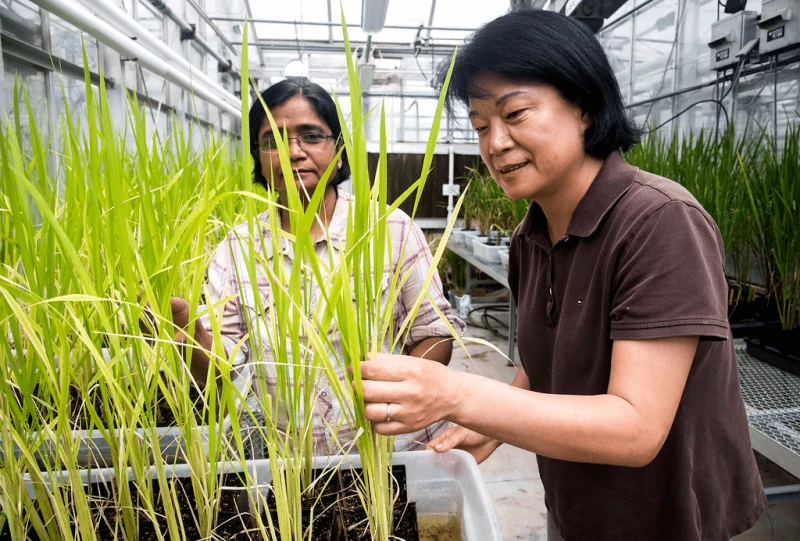Here’s the skinny on fast-emerging genetic engineering tools that are rapidly improving global farming
Here’s the skinny on fast-emerging genetic engineering tools that are rapidly improving global farming


Genetic engineering and gene-editing tools are by no means a panacea for the time-sensitive agricultural and food-related challenges we face – but they could help, if given the opportunity.
“Advantages of genome editing are that these changes are precisely targeted and can be made within already excellent plant varieties, improving one trait, such as disease resistance, without altering any other traits,” says [Dr. Kevin] Pixley. “This contrasts with most breeding techniques, where mating a disease-resistant parent with another excellent parent produces progeny with half of the traits from each parent.”
A variety of laboratory techniques can be utilized to create transgenic crops. A simplistic overview of the process is as follows:
- Scientists decide which trait they want to insert into a plant and identify an organism that possesses the gene encoding that trait.
- The gene is isolated and copied, typically using polymerase chain reaction (PCR).
- To insert the gene into the organism’s cells, a vector is required that can carry the gene into the plant’s cells, such as a plasmid.
- The plasmid is introduced to the host plant’s cells, either using agrobacterium-based methods or biolistics.
- Once the gene is inserted, the cells are cultured in a laboratory and those that have successfully incorporated the gene are utilized to grow plants.
…
A variety of genome-editing technologies now exist, such as zinc finger nucleases (ZFNs), homing endonucleases or meganucleases (HEs), transcriptional activator-like effector nucleases (TALENs) and the recent Nobel-prize winning CRISPR/Cas nuclease system. While their molecular components differ, these approaches all generate double-strand breaks in the DNA, activating the cell’s endogenous DNA repair pathway.
…
Other agronomic traits introduced using CRISPR technology include fungal, viral and temperature resistance and increased crop yield. Examples of consumer-focused traits include reduced browning, improved shelf-life, reductions in allergens and traits that address broader health issues.
This is an excerpt. Read the original post here

 | Videos | More... |

Video: Nuclear energy will destroy us? Global warming is an existential threat? Chemicals are massacring bees? Donate to the Green Industrial Complex!
 | Bees & Pollinators | More... |

GLP podcast: Science journalism is a mess. Here’s how to fix it

Mosquito massacre: Can we safely tackle malaria with a CRISPR gene drive?

Are we facing an ‘Insect Apocalypse’ caused by ‘intensive, industrial’ farming and agricultural chemicals? The media say yes; Science says ‘no’
 | Infographics | More... |

Infographic: Global regulatory and health research agencies on whether glyphosate causes cancer
 | GMO FAQs | More... |

Why is there controversy over GMO foods but not GMO drugs?

How are GMOs labeled around the world?

How does genetic engineering differ from conventional breeding?
 | GLP Profiles | More... |

Alex Jones: Right-wing conspiracy theorist stokes fear of GMOs, pesticides to sell ‘health supplements’




 Viewpoint — Fact checking MAHA mythmakers: How wellness influencers and RFK, Jr. undermine American science and health
Viewpoint — Fact checking MAHA mythmakers: How wellness influencers and RFK, Jr. undermine American science and health Viewpoint: Video — Big Solar is gobbling up productive agricultural land and hurting farmers yet providing little energy or sustainabilty gains
Viewpoint: Video — Big Solar is gobbling up productive agricultural land and hurting farmers yet providing little energy or sustainabilty gains Fighting deforestation with CO2: Biotechnology breakthrough creates sustainable palm oil alternative for cosmetics
Fighting deforestation with CO2: Biotechnology breakthrough creates sustainable palm oil alternative for cosmetics Trust issues: What happens when therapists use ChatGPT?
Trust issues: What happens when therapists use ChatGPT? 30-year-old tomato line shows genetic resistance to devastating virus
30-year-old tomato line shows genetic resistance to devastating virus California, Washington, Oregon forge immunization alliance to safeguard vaccine access against federal undermining
California, Washington, Oregon forge immunization alliance to safeguard vaccine access against federal undermining The free-range chicken dilemma: Better for birds, but with substantial costs
The free-range chicken dilemma: Better for birds, but with substantial costs ‘You have to treat the brain first’: Rethinking chronic pain with Sanjay Gupta
‘You have to treat the brain first’: Rethinking chronic pain with Sanjay Gupta
